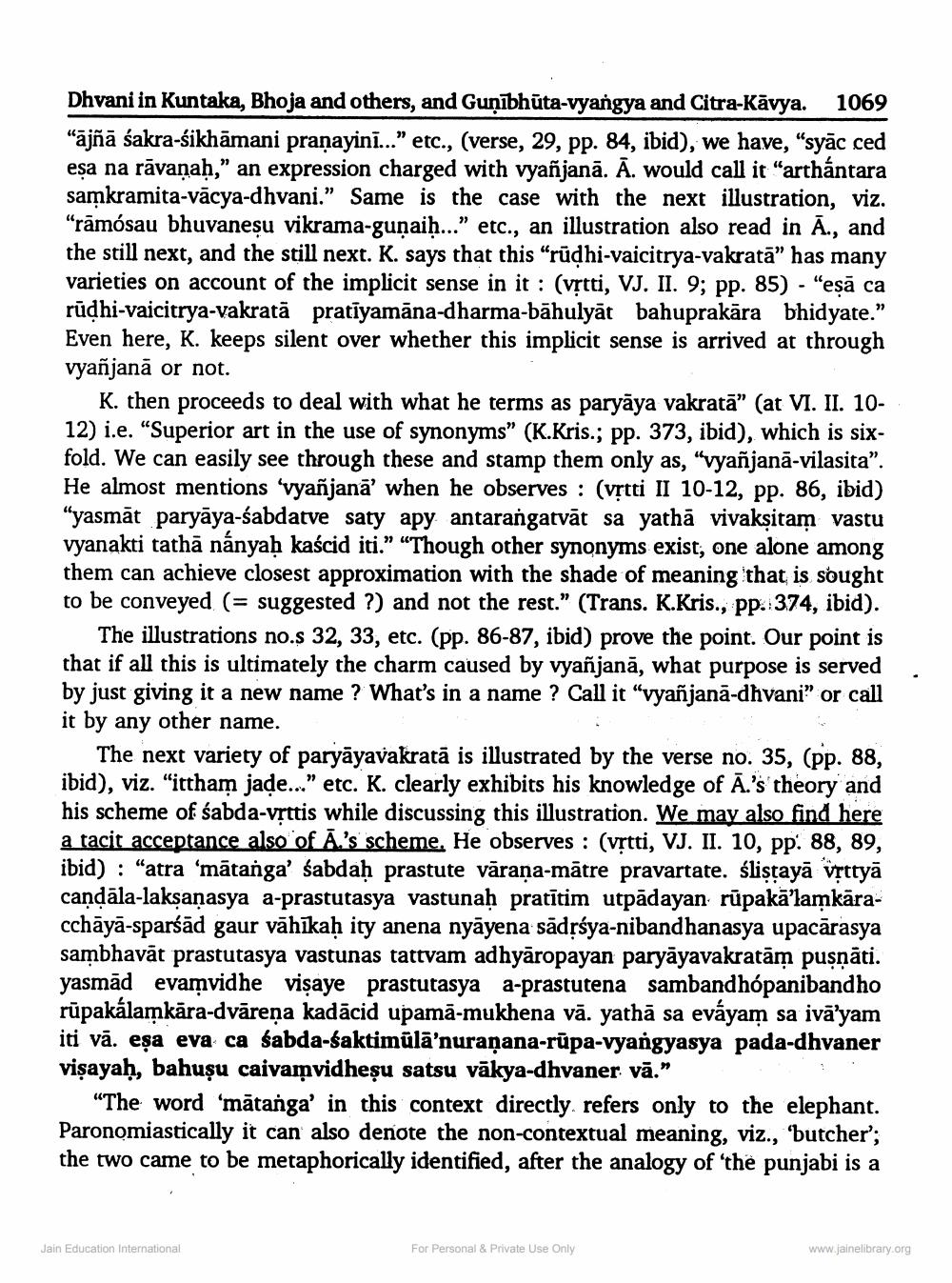________________
Dhvani in Kuntaka, Bhoja and others, and Guņībhūta-vyangya and Citra-Kāvya. 1069 "ājñā sakra-śikhāmani pranayini..." etc., (verse, 29, pp. 84, ibid), we have, "syāc ced esa na rāvanah," an expression charged with vyañjanā. Ā. would call it "arthántara samkramita-vācya-dhvani.” Same is the case with the next illustration, viz. "rāmósau bhuvanesu vikrama-gunaih..." etc., an illustration also read in A., and the still next, and the still next. K. says that this "rūdhi-vaicitrya-vakratā” has many varieties on account of the implicit sense in it : (vịtti, VJ. II. 9; pp. 85) - "eşā ca rūdhi-vaicitrya-vakratā pratiyamāna-dharma-bāhulyāt bahuprakāra bhidyate.” Even here, K. keeps silent over whether this implicit sense is arrived at through vyañjanā or not.
K. then proceeds to deal with what he terms as paryāya vakratā” (at VI. II. 1012) i.e. “Superior art in the use of synonyms” (K.Kris.; pp. 373, ibid), which is sixfold. We can easily see through these and stamp them only as, "vyañjanā-vilasita”. He almost mentions 'vyañjana' when he observes : (vịtti II 10-12, pp. 86, ibid) "yasmāt paryāya-śabdatve saty apy antarangatvāt sa yathā vivaksitam vastu vyanakti tathā nânyah kaścid iti." "Though other synonyms exist, one alone among them can achieve closest approximation with the shade of meaning that is sought to be conveyed (= suggested ?) and not the rest.” (Trans. K.Kris., pp. 374, ibid).
The illustrations no.s 32, 33, etc. (pp. 86-87, ibid) prove the point. Our point is that if all this is ultimately the charm caused by vyañjanā, what purpose is served by just giving it a new name ? What's in a name ? Call it "vyañjana-dhvani” or call it by any other name.
The next variety of paryāyavakratā is illustrated by the verse no. 35, (pp. 88, ibid), viz. "ittham jade..." etc. K. clearly exhibits his knowledge of Ā.'s theory and his scheme of sabda-vșttis while discussing this illustration. We may also find here a tacit acceptance also of Ā.'s scheme. He observes : (vrtti, VJ. II. 10, pp. 88, 89, ibid) : "atra ‘mātanga' śabdah prastute vārana-mātre pravartate. ślistayā vrttyā candāla-lakṣaṇasya a-prastutasya vastunah pratītim utpādayan rūpakā’lamkāracchāyā-sparśād gaur vāhīkaḥ ity anena nyāyena sādņśya-nibandhanasya upacārasya sambhavāt prastutasya vastunas tattvam adhyāropayan paryāyavakratām puşnāti. yasmād evamvidhe vişaye prastutasya a-prastutena sambandhópanibandho rūpakalamkāra-dvāreņa kadācid upamā-mukhena vā. yathā sa evayam sa ivā'yam iti vā. eșa eva ca sabda-saktimülā'nuraṇana-rūpa-vyangyasya pada-dhvaner visayah, bahuỵu caivanvidhegu satsu vakya-dhvaner vã.”
“The word 'mātanga' in this context directly refers only to the elephant. Paronomiastically it can also denote the non-contextual meaning, viz., 'butcher'; the two came to be metaphorically identified, after the analogy of the punjabi is a
Jain Education International
For Personal & Private Use Only
www.jainelibrary.org




